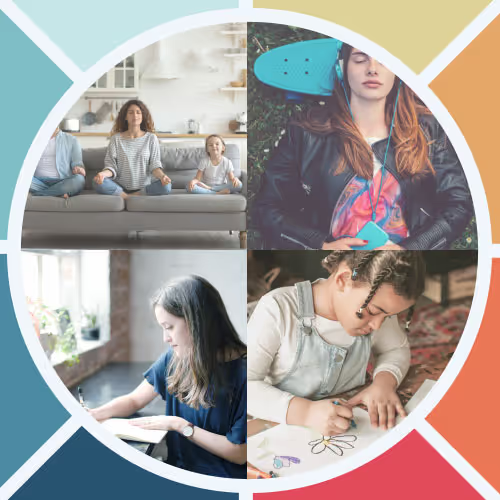Mindful Tune Ups – Rediscovering the Lost Art of Listening
Published: 2nd July 2025
By Chris Woods, The Chris Woods Groove Orchestra and host of The Music Education Podcast.

Mindfulness, defined as focused awareness, is not a new concept in music education. Yet today, it is more vital than ever. It is not a new skill, but a forgotten one that music educators must urgently help revive.
You can begin now with Mindful Tune-Ups on the Charanga platform.
In this blog, I will explore why mindfulness isn’t just a nice extra – it’s central to music-making. I’ll examine how we’re slowly losing the ability to notice, how the world around us is altering our senses, and how we can gently guide students back to something humans have always done: tune in.
Acoustic Ecology: Our Changing Sound World
Let’s start with something we don’t always think about: the sound of the world around us. It changes constantly, season to season, moment to moment. This is what’s called acoustic ecology. In winter, you might hear bare trees rustling in the wind. In spring, birdsong returns.
But acoustic ecology also evolves in tandem with human progress. Technology and industry have transformed the soundscape, especially in the last decade. Our environments are now louder, faster, and more complex than ever.
And without realising it, we’ve trained ourselves to tune out. We do it because we have to. It’s how we cope with all the noise. From childhood, we’re taught to ignore the world around us and focus on tasks. We walk into town, we sit in class, we go to work – and all the while, our ears are learning to filter out the ‘distractions’.
And then there’s the big one: our phones. Today’s attention-grabbing media means that our ability to notice the world, particularly its sounds, is under constant attack. The result? Many of us (and definitely our students) are slowly losing the ability to connect with the sonic world around us. We’re not just distracted, we’re disconnected. And that’s where music educators can help.
Mental Health and Sound
We all know how good it feels to sit in nature, surrounded by birdsong or the rustle of trees. Compare that to rushing through a busy street while checking Instagram. There’s no contest.
Modern life can be overwhelming. But one thing we often overlook is the impact of sound on our mental well-being. Noise pollution, overstimulation, constant alerts. These things drain us.
Now, we can’t change the layout of towns or magically switch off social media. But we can help our students (and ourselves!) reconnect. By using simple exercises, we can encourage young people to notice the sounds around them, to slow down and listen. We’re not just teaching musical skills, we’re supporting mental health. And yes, the tool we use is mindfulness.
Music: It All Starts with Sound
Let’s get to the heart of it – music itself.
At its core, all musical ability stems from one thing: the capacity to engage with sound. Even the simplest musical task requires attunement, a deep connection with the auditory world.
This connection goes beyond recognising instruments or identifying styles. It’s about engagement. And yet, in a world that constantly pulls us away from sound, building this connection is increasingly difficult.
Picture a string quartet or a DJ set where the performer seems disconnected. It feels flat, empty, even disconcerting. We instinctively expect musicians to be deeply present in the sound.
Surprisingly, however, little in today’s music curriculum actively supports students in developing this essential skill. We seem to assume it will come naturally. But this assumption is no longer fair. Young people are growing up in an age where distraction is the norm and disconnection from the natural world is widespread.
Mindfulness can help us bridge this gap. It allows students – and educators – to reconnect and re-engage.
‘But I Don’t Need Mindfulness!’
Maybe you’re reading this thinking, ‘I don’t do mindfulness, but I love music. I notice sound all the time.’ And that’s great! If you’re able to stay connected to sound, to your surroundings, and to what you’re doing, then guess what? You’re already practising mindfulness. You’re doing it instinctively.
The difference is, for most of us, that ability used to come more naturally. A quieter world meant we had more space to pay attention. These days, it takes more effort. So we need to train that attention like a muscle, and that’s where mindful tune-ups come in.
So What Are Mindful Tune-Ups?
As mentioned above, Mindful Tune-Ups are now part of Charanga Musical School’s program. The resources were created by music educator Michelle D. Woods and are designed to help students (and teachers) build that vital listening muscle. They are simple, practical activities that encourage noticing, focus, and presence. No deep meditation, no incense sticks – just short, meaningful ways to reconnect with sound! And the impact? It’s powerful. Not just musically, but emotionally and mentally, too. Head on over to the Freestyle section and give them a try!
Try it yourself - take a free 30-day trial
See what Musical School can do for you and the young people you work with.
- Week-by-week lessons for students aged 5–11
- A customisable library of songs, creative tools and interactive teaching resources
- YuStudio®, a beginner-friendly DAW for schools
- Unlimited access for every teacher and student at your school

